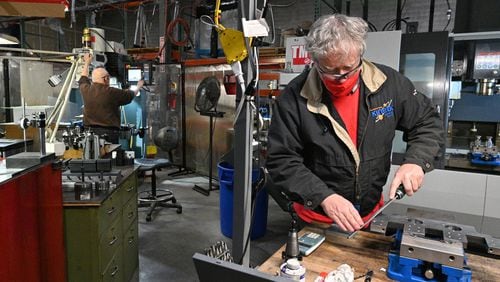As the pandemic hit, orders dropped at Winton Machine in Suwanee, chilled by confusion and uncertainty.
The 23-year-old maker of fabrication equipment — machines that make tubular parts for other machines — has buyers ranging from the corporate like General Electric to the military like the U.S. Navy. Many put their business on hold.
“A lot of customers can’t travel, so they can’t come look before ordering,” said Lisa Winton, the chief executive. “And we normally go to train people on the machines. Some factories wanted us to come and some factories said no.”
But in the last few months of 2020, business picked up.
Overseas orders were a big part of that, Winton said. “We have a lot of opportunities. We sold into Taiwan. We’ve sold to Israel for their missile defense system.”
Exports are a larger story for Georgia as well.
While the pandemic roiled the U.S. economy and global trade, Georgia exports weathered the storm better than many, jumping from the 12th-ranked state to 10th last year with $38.8 billion in exports, according to government data.
Because of the pandemic shutdowns, Georgia exports fell from the previous year. Like many U.S. states, Georgia still has a massive trade deficit, importing more from other countries than it exports. The state also has fewer jobs in manufacturing — which power about 90% of exports — than a year ago.
But exports picked up in late 2020, rising 17% through the Port of Savannah — a key conduit — in the last three months of the year compared with the previous three months. Exports grew again in January, according to the Georgia Ports Authority.
Exports matter because they expand markets for U.S. companies and bolster manufacturing, a sector that typically has a larger economic ripple effect on the local economy while paying higher-than-average wages.
The momentum could help power a post-vaccination recovery this year, said Mary Waters, deputy commissioner for international trade at the Georgia Department of Economic Development. “The prognosis right now is definitely about resilience.”
Credit: HYOSUB SHIN / AJC
Credit: HYOSUB SHIN / AJC
Exports nationally fell 14.4% in 2020, while Georgia’s were down less than half of that, Waters said. “It’s the diversity of the mix. We don’t have all our eggs in one basket and that can make a difference.”
Georgia’s exports benefitted from having more manufacturing industries that did well during the pandemic, like aerospace and aircraft, paper and timber, automotive and agriculture. Meanwhile, agriculture — about 10% of exports — was bouncing back with strong growth in exports of poultry, cotton and peanuts.
Georgia also has less of a presence in sectors that did badly last year, like oil and gas.
Some of Georgia’s relative strength in exports was likely an unexpected benefit of the pandemic, as global supply chains were disrupted, said Christopher Fagan, manufacturing practice leader at Atlanta-based Moore Colson CPAs and Advisors.
Exports of vehicles and parts were up, a sign that domestic production was diverted overseas, he said. “To see the large numbers of vehicles shipped out tells me that their supply chain was disrupted and then re-routed.”
Kia, which has a huge plant in West Point, made vehicles almost exclusively for the domestic market, a spokesman said. But there are now a string of auto plants in the southeast — including BMW, Mercedes, Volkswagen and Honda — that can use the Port of Savannah to adjust to shortfalls elsewhere. While Kia is the only car-making plant in Georgia, there are many auto parts suppliers in the state.
Meanwhile, shipments of civilian aircraft like Savannah-based Gulfstream were unaffected by the pandemic since orders are often placed two years in advance, Fagan said.
Moreover, virus-linked shutdowns in Georgia were limited, he said. “Georgia was relatively aggressive in its definition of essential businesses that could stay open, so our supply chain here was not hit as badly.”
A few destinations saw year-over-year increases in exports from Georgia.
Exports to Germany were up, mainly because of vehicles and aircraft shipments, according to Census Bureau data. Georgia also exported more to China, partly because of an agricultural bounce-back from the previous year, when China had retaliated against U.S. tariffs by limiting products like Georgia’s peanuts, cotton and poultry.
Credit: HYOSUB SHIN / AJC
Credit: HYOSUB SHIN / AJC
Cross-border trade remains very uneven. The U.S. trade deficit grew to a record $678.7 billion last year. Georgia imported $98.9 billion of goods and services, more than double what it exported.
And there has been no big rebound in manufacturing jobs, despite former President Donald Trump’s promises and four years of tariff wars and harsh rhetoric, especially about China.
Georgia’s manufacturing workforce, which had been growing since 2010, continued to expand in the first years of the Trump administration, but the pace of growth slowed even before the pandemic. Georgia had about 389,000 manufacturing jobs at the end of December, down from about 403,000 a year earlier, representing less than a tenth of the state’s jobs, according to the Bureau of Labor Statistics.
That moderation has more to do with automation, improved efficiency and what Americans spend money on than it does on Trump’s tariffs or the value of the dollar, said Ray Hill, a professor of finance at Emory University’s Goizueta Business School.
Another reason trade wars didn’t bring jobs back was the hesitance of companies to make big decisions based on easily changed policies, said Scott Ellyson, chief executive of Atlanta-based East West Manufacturing, which does contract manufacturing overseas and in the United States.
But manufacturing still packs a punch, even if the impact is most visible around the big plants, said economist Tom Smith of Emory’s Goizueta School of Business.
Even modestly sized operations have an impact, their success adding to the local economy as they buy parts and supplies and hire accountants, marketers and lawyers.
Winton Machine has 38 employees who make between $17 and $30 an hour and is searching for more, Lisa Winton said. “We are trying to add a second shift. Right now, we are looking for machinists.”
Exports can be a key factor in growth this year, she said. “We just sold our first machine into Spain — it’s very exciting.”
Georgia exports that increased in 2020 from previous year
Passenger and motor vehicles: +43.6%
Chicken cuts: +6.8%
Cotton: +12.1%
Medicine and pharmaceutical products: +2.6%
Paper: +1.5%
Data processing parts: +4%
Jets and propellers: +25.2%
Sources: Census Bureau, Bureau of Economic Analysis
__________________________________
2020 Georgia trade
Exports: $38.8 billion
Imports: $98.9 billion
Sources: Census Bureau, Bureau of Economic Analysis, Georgia Department of Economic Development
__________________________________
Top exporting states in 2020
Texas
California
New York
Louisiana
Illinois
Florida
Ohio
Michigan
Washington
Georgia
Sources: Census Bureau, Bureau of Economic Analysis, Georgia Department of Economic Development
__________________________________
Share of total manufacturing
Electronics, computers, U.S.: 12.0%
Electronics, computers, Georgia: 3.9%
Food and beverage, U.S.: 11.6%
Food and beverage, Georgia: 20.6%
Paper, U.S.: <1%
Paper, Georgia: 6.6%
Aerospace, U.S.: 6.3%
Aerospace, Georgia: 8.2%
Petroleum, U.S.: 5.2%
Petroleum, Georgia: <1%
Source: Census Bureau, Bureau of Economic Analysis
Number of manufacturing jobs, Georgia, December
2010: 345,500
2011: 350,100
2012: 355,300
2013: 359,400
2014: 372,200
2015: 382,700
2016: 391,300
2017: 399,900
2018: 407,400
2019: 403,300
2020: 389,400
Source: Bureau of Labor Statistics









